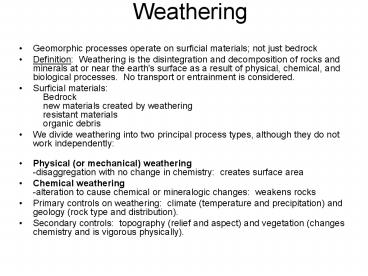Weathering - PowerPoint PPT Presentation
1 / 33
Title: Weathering
1
Weathering
- Geomorphic processes operate on surficial
materials not just bedrock - Definition Weathering is the disintegration and
decomposition of rocks and minerals at or near
the earth's surface as a result of physical,
chemical, and biological processes. No transport
or entrainment is considered. - Surficial materials Bedrock new
materials created by weathering resistant
materials organic debris - We divide weathering into two principal process
types, although they do not work independently - Physical (or mechanical) weathering
-disaggregation with no change in chemistry
creates surface area - Chemical weathering -alteration to cause
chemical or mineralogic changes weakens rocks - Primary controls on weathering climate
(temperature and precipitation) and geology (rock
type and distribution). - Secondary controls topography (relief and
aspect) and vegetation (changes chemistry and is
vigorous physically).
2
http//www.oneworldhull.co.uk
Coffee making as analogy for physical and
chemical weathering
http//www.peets.com/
http//www.peets.com/
http//www.peets.com/
3
Increase surface area
http//www.gly.fsu.edu/7Esalters/GLY1000/10Weathe
ring_Erosion/Slide10.jpg
4
http//www.gly.fsu.edu/7Esalters/GLY1000/10Weathe
ring_Erosion/Slide6.jpg
5
Environmental control on weathering
6
(No Transcript)
7
Chemical weathering
- -Decomposition by chemical processes to cause
chemical and mineralogic changes - -Disequilibrium response surface of the earth
is much different than the environment in which
most rocks form. - -Genesis of material to be weathered is most
important. What are the differences in physical
and chemical conditions?
8
http//www.gly.uga.edu/railsback/GeologicalDiagram
s2.html
9
Many plant species have a symbiotic partnership
with a unique group of soil organisms called
mycorrhizal fungi. They enhance chemical
weathering of rock for the benefit of plants
10
edutel.musenet.org8042/.../close_lamb.JPG
wps.prenhall.com/.../1268/1298711/stone-6.gif
http//www.env.duke.edu/eos/geo41/wea027.gif
11
http//www.gly.fsu.edu/7Esalters/GLY1000/10Weathe
ring_Erosion/Slide12.jpg
12
Relative resistance Two simple ways to
anticipate resistance to chemical weathering
1) Rocks Igneous and metamorphic rocks (least
stable) V Sedimentary rocks V
Weathering products (most stable environment
most similar to surface)
13
http//www.gly.uga.edu/railsback/GeologicalDiagram
s2.html
14
Relative resistance Two simple ways to
anticipate resistance to chemical weathering
2) Empirical formulation for minerals (Goldich,
1938 compared parent and resulting minerals)
(inverse Bowen's reaction series more shared
Si-O bonds means more resistance to weathering)
Quartz Muscovite Biotite Amphibole K
feldspar Pyroxene Na-Plag Olivine Ca-Plag
15
Chemical weathering
Processes of decomposition
- Oxidation and reduction
- Solution
- Hydrolysis
- Mobility
- Leaching
- pH
- Chelation
Occurs on mineral surfaces (see figure 3.3 from
Ritter et al.)
16
Oxidation-Reduction
- Oxidation occurs rapidly above the water table
(wet, but interstitial spaces are filled with
air) red colors. - Element loses electrons to an oxygen ion.
- "Weathering of iron-bearing minerals"
- Reduction occurs below water table or in other
conditions of low oxygen (anoxic) black colors. - Reactions
17
http//www.gly.fsu.edu/7Esalters/GLY1000/10Weathe
ring_Erosion/Slide18.jpg
18
Solution
- Extract ions from crystal lattice and eventually
the mineral falls apart. The freed ions go into
solution and may subsequently precipitate. - Variations in mineral solubility are strongly
dependent on crystal structure (esp. crystalline
versus amorphous) and pH (4-9 is typical for soil
waters) - Remaining insoluble materials might be Fe3 or
Al2O3 (Bauxite) - Most important rx
19
Hydrolysis
- Reaction between cations which are replaced by H
from disassociated water. Important as basic way
in which many silicates are attacked and
decomposed.
Ion exhange Substitution for ions in solution for
those held by mineral grains -often onto surface
of clay particles -generates acids, and pulls
some cations (Ca, Na, K, others) out of solution
20
http//www.gly.fsu.edu/7Esalters/GLY1000/10Weathe
ring_Erosion/Slide14.jpg
21
Hydrolysis
- Will keep going until solvent is saturated with
respect to cations - What keeps the reaction going?
- Leaching--movement of groundwater H supplied
and cations (K, Ca2, Na, Mg2) removed. - Acids often come from rainfall (CO2 in the
atmosphere) and from organic material in the
soil humic acid - CO2 (gas) H2O (water) lt-gt H2CO3 (carbonic
acid) lt-gt H (hydrogen ion) HCO3-
(bicarbonate ion)
22
http//www.gly.uga.edu/railsback/1121WeatheringChe
mCaliche.jpeg
23
Leaching
- Movement of water through weathering zone
- 1) removes dissolved minerals 2) adds fresh H
(keeping things in solution) 3) moves material
within weathering zone possibly allowing
precipitation of new minerals
24
Mobility
- Controls extent of alteration
pH H concentration as pH goes down, mobility
goes up
http//www.gly.uga.edu/railsback/GeologicalDiagram
s2.html
25
Chelation
- Normally immobile metal ions form more than one
bond with molecules of the chelating agent
resulting in the formation of a ring structure
incorporating the metal ion. - Often a means of accelerated chemical weathering
by plants. - Plants are capable of putting into solution or
absorbing substantial portions of the total mass
of the rock on which they grow.
http//en.wikipedia.org/wiki/ImageLichen_squamulo
se.jpg
26
General comments about chemical weathering
Latitudinal control on weathering
27
Clays are key weathering products
28
http//www.gly.uga.edu/railsback/1121PeriodicTable
3.jpeg
29
(No Transcript)
30
Karsted landscape in China
http//daac.gsfc.nasa.gov/geomorphology/GEO_7/geo_
images_KL-1/FigKL-1.3.gif
31
Travertine-cemented colluvium on Colorado River
slope in the Grand Canyon
Vasey's Paradise in the Grand Canyon--lots of
dissolved ions in that water from dissolution and
chemical weathering of carbonates.
32
Birkeland
Ecological role of weathering
33
Lots of Ca in these desert plants!































